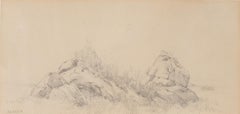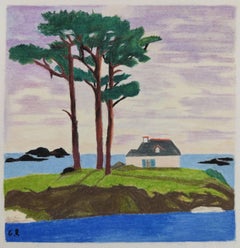John Singer Sargent Art
The most sought-after society portraitist of his time — as well as a highly accomplished painter of landscapes and genre scenes — John Singer Sargent was born in Florence, Italy, to well-to-do American parents. The French-trained Sargent depicted his sitters with a bravura brushstroke and a degree of originality that were highly progressive at the time. As a result, he enjoyed critical notice and important patronage, but also weathered some controversy.
Though Sargent spent most of his life abroad, his American ties brought him numerous portrait commissions as well as important commissions for the mural programs at Boston's Museum of Fine Arts and the Boston Public Library.
Sargent's works, whether in oil, watercolor, or charcoal, are marked with naturalness and a distinct sense of immediacy due to his remarkable technical facility as an artist. Whether monumental portraits or casual outdoor scenes, his works possess a freshness and fluidity seldom matched in any era.
Sargent spent much of his free time painting and sketching outdoors, and his landscapes, architectural, and subject pictures — influenced by his friendship with Claude Monet and frequently executed in watercolor — depict the various locations he visited, including Italy, rural England, Giverny, the Mediterranean, northern Africa, and the Alps. The artist devoted a large portion of his late career to his mural projects, and also served as a war artist during World War I.
Find original John Singer Sargent drawings, paintings and other art on 1stDibs.
Late 19th Century Impressionist John Singer Sargent Art
Paper, Pencil, Watercolor
1870s Impressionist John Singer Sargent Art
Paper, Pencil, Graphite
1870s American Impressionist John Singer Sargent Art
Paper, Pencil
1920s American Impressionist John Singer Sargent Art
Paper, Pencil
21st Century and Contemporary Impressionist John Singer Sargent Art
Pastel, Archival Paper, Color Pencil
Gabriel RiesnertAu Bord de l'eau, Original Drawing, Pastel, Trees and House along the seafront, 2019
21st Century and Contemporary Impressionist John Singer Sargent Art
Archival Paper, Color Pencil, Pastel
1910s American Impressionist John Singer Sargent Art
Paper, Watercolor
Early 1900s Impressionist John Singer Sargent Art
Laid Paper, Pencil, Watercolor
1990s American Impressionist John Singer Sargent Art
Watercolor, Paper
1940s American Impressionist John Singer Sargent Art
Paper, Charcoal
Early 20th Century American Impressionist John Singer Sargent Art
Paper, Watercolor
Early 2000s American Impressionist John Singer Sargent Art
Charcoal, Paper
21st Century and Contemporary Impressionist John Singer Sargent Art
Gouache, Color Pencil
1940s American Impressionist John Singer Sargent Art
Paper, Charcoal
Early 20th Century Impressionist John Singer Sargent Art
Watercolor, Pencil, Paper
John Singer Sargent art for sale on 1stDibs.
Artists Similar to John Singer Sargent
- 1stDibs ExpertApril 5, 2022John Singer Sargent painted a number of notable people during the late 19th and early 20th centuries. Some of his most famous subjects include the writer Robert Louis Stevenson and U.S. Presidents Theodore Roosevelt and Woodrow Wilson. You'll find a range of John Singer Sargent art on 1stDibs.
- 1stDibs ExpertFebruary 27, 2024You can see John Singer Sargent paintings at a number of museums. The largest collection of the American artist's work is in the Museum of Fine Arts in Boston, Massachusetts. Other institutions that have Sargent's work in their collections include the National Gallery of Art in Washington, D.C.; Harvard Art Museums in Cambridge, Massachusetts; the Isabella Gardner Museum in Boston; the Art Institute of Chicago in Chicago, Illinois; the Museum of Fine Arts in Houston, Texas; and the Amon Carter Museum of American Art in Fort Worth, Texas. On 1stDibs, shop an assortment of John Singer Sargent art.




